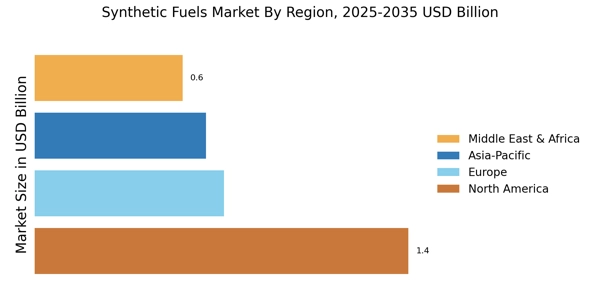Increasing Environmental Regulations
The Synthetic Fuels Market is significantly influenced by the tightening of environmental regulations aimed at reducing greenhouse gas emissions. Governments worldwide are implementing stringent policies that encourage the transition from fossil fuels to cleaner alternatives. This regulatory landscape is fostering investments in synthetic fuels, as they offer a lower carbon footprint compared to traditional fuels. For instance, the European Union's Green Deal aims to make Europe climate-neutral by 2050, which could potentially increase the demand for synthetic fuels. As a result, companies in the Synthetic Fuels Market are likely to prioritize compliance with these regulations, driving innovation and market growth.
Investment in Renewable Energy Sources
The Synthetic Fuels Market is benefiting from increased investment in renewable energy sources, which are essential for producing synthetic fuels sustainably. As countries strive to diversify their energy portfolios, investments in wind, solar, and hydroelectric power are becoming more prevalent. These renewable sources can be utilized to generate the electricity needed for synthetic fuel production, thereby reducing reliance on fossil fuels. Reports suggest that investments in renewable energy could exceed USD 1 trillion by 2025, creating a favorable environment for the Synthetic Fuels Market to thrive. This synergy between renewable energy and synthetic fuels may lead to innovative production methods and enhanced market growth.
Strategic Partnerships and Collaborations
Strategic partnerships and collaborations within the Synthetic Fuels Market are emerging as a key driver of growth. Companies are increasingly joining forces with research institutions, technology providers, and other stakeholders to accelerate the development and commercialization of synthetic fuels. These collaborations facilitate knowledge sharing, resource pooling, and risk mitigation, which are crucial for navigating the complexities of the market. For instance, partnerships between energy companies and technology firms are enabling the adoption of cutting-edge production techniques. As the industry evolves, such alliances are likely to play a pivotal role in shaping the future of the Synthetic Fuels Market, fostering innovation and expanding market reach.
Rising Consumer Awareness and Demand for Sustainability
Consumer awareness regarding climate change and environmental sustainability is on the rise, significantly impacting the Synthetic Fuels Market. As individuals and organizations seek to reduce their carbon footprints, the demand for sustainable fuel alternatives is increasing. This shift in consumer behavior is prompting manufacturers to invest in synthetic fuels, which are perceived as a viable solution to meet energy needs while minimizing environmental harm. Market data indicates that the demand for synthetic fuels could grow by over 15% annually as consumers increasingly prefer products that align with their sustainability values. This trend is likely to propel the Synthetic Fuels Market forward.
Technological Innovations in Synthetic Fuels Production
The Synthetic Fuels Market is experiencing a surge in technological innovations that enhance production efficiency and reduce costs. Advanced methods such as gas-to-liquids (GTL) and biomass-to-liquids (BTL) are gaining traction, allowing for the conversion of natural gas and biomass into high-quality synthetic fuels. These innovations not only improve yield but also minimize environmental impact, aligning with sustainability goals. As of 2025, the market for synthetic fuels is projected to reach approximately USD 200 billion, driven by these advancements. The integration of artificial intelligence and machine learning in production processes further optimizes operations, suggesting a promising future for the Synthetic Fuels Market.


















Leave a Comment